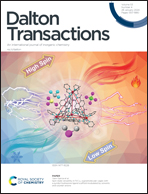Ruthenium polyhydrides supported by rigid PCP pincer ligands: dynamic behaviour and reactions with CO2†
Abstract
Two rigid β-elimination immune PCcarbeneP pincer ligands, differing in their electron donor properties by variation of the substitution pattern on the aromatic linker arms, were complexed to ruthenium to form the dichlorides LRRuCl2 (R = H or NMe2). These compounds were converted to hydrido chlorides by treatment with dihydrogen (H2) and a base. By converting to tert-butoxide derivatives in situ under an atmosphere of H2, the poly hydride PCalkylP complexes LHRRu(H)3 compounds were generated. In these complexes, H2 has added across the Ru![[double bond, length as m-dash]](https://www.rsc.org/images/entities/char_e001.gif) C bond in the PCcarbeneP starting materials. The polyhydrides are dynamic in solution and extensive NMR studies helped to elucidate the speciation and fluxional processes operative in this dynamic system. The polyhydride complexes react rapidly with CO2 to give the PCcarbeneP formato hydride complexes LRRu(H)-κ2-O2CH. For R = H, the 1,2-hydride shift from the anchoring alkyl of the PCalkylP carbon to the metal is reversible, but for R = NMe2 it is irreversible. The CO2 incorporated into the formato ligand of these compounds exchanges with free CO2via a bimolecular mechanism that is more rapid for R = NMe2 than for R = H; plausible explanations for this observation are proffered. Experiments designed to evaluate the efficacy of the R = NMe2 formato hydride complex as a catalyst precursor for CO2 hydrogenation to formate salts reveal poor performance in comparison to state-of-the-art ruthenium-based catalysts. This is due primarily to the precipitation of a dimeric μ-κ2-κ1-CO3 carbonate complex that is not an active catalyst for the reaction.
C bond in the PCcarbeneP starting materials. The polyhydrides are dynamic in solution and extensive NMR studies helped to elucidate the speciation and fluxional processes operative in this dynamic system. The polyhydride complexes react rapidly with CO2 to give the PCcarbeneP formato hydride complexes LRRu(H)-κ2-O2CH. For R = H, the 1,2-hydride shift from the anchoring alkyl of the PCalkylP carbon to the metal is reversible, but for R = NMe2 it is irreversible. The CO2 incorporated into the formato ligand of these compounds exchanges with free CO2via a bimolecular mechanism that is more rapid for R = NMe2 than for R = H; plausible explanations for this observation are proffered. Experiments designed to evaluate the efficacy of the R = NMe2 formato hydride complex as a catalyst precursor for CO2 hydrogenation to formate salts reveal poor performance in comparison to state-of-the-art ruthenium-based catalysts. This is due primarily to the precipitation of a dimeric μ-κ2-κ1-CO3 carbonate complex that is not an active catalyst for the reaction.

- This article is part of the themed collection: Celebrating International Women’s Day 2025: Women in Inorganic Chemistry


 Please wait while we load your content...
Please wait while we load your content...